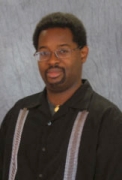2015 Summer Research Grant Awardees
The Office of Research and Graduate Programs is pleased to celebrate these Summer Research Fellowships and Research Support Grant recipients:

Dr. David Barrett
Department of Political Science
College of Liberal Arts and Sciences
SRF: Intelligence and Politics in the Era of John F. Kennedy’s Presidency
Although scholars have written many books about President John F. Kennedy and numerous books about events relating to the Central Intelligence Agency during his presidency, we still lack a history of relations between the CIA and JFK's White House that covers all of the Kennedy era, from January 1961 to November 1963. In recent years, Professor David M. Barrett of the Political Science Department has been examining voluminous papers of President Kennedy, his advisers, leaders of the CIA, news reporters and columnists, and members of the U.S. Congress. His planned book will examine the interactions of CIA leaders with elected officials, especially the President and influential Congress members, in order to understand more clearly whether the Agency was responsive to directions from those elected leaders, or whether it often "free lanced" in carrying out covert operations and intrusive intelligence gathering around the world.

Dr. Danai Chasaki
Department of Electrical and Computer Engineering
College of Engineering
SRF: Adaptive Security Mechanisms for Multi-core Modern Routers
In the interest of improving programming flexibility, commercial routers are nowadays designed with additional components to allow programmable packet processing. However, the inclusion of such components has made routers vulnerable to a new wave of malicious attacks occurring at the data plane level. Specifically, these attacks are perpetrated by compromising packet processors’ engines through carefully crafted “attack” data packets. This project aims at developing a secure packet-processing platform, which can protect the Internet router infrastructure from attacks that are targeted at vulnerabilities in the data plane of the network.
Currently, there is no adequate monitoring device to check on packet processing activities within commercial routers, and this forms the basis of the proposed project. The two main objectives are: (1) to design a prototype for a cost-effective multicore hardware monitor that can detect malicious attacks rapidly and reliably at the data plane level of a network, (2) to analyze the prototype via its implementation on a NetFPGA platform, which is an accepted standard for experimental testing of such types of devices.

Dr. Robert Curry
Department of Biology
College of Liberal Arts and Sciences
SRF/RSG: Herbivorous Exploitation of Ant-Acacia Mutualisms by Jumping Spiders: Can There Be More Than One?
Ecological mutualisms—systems where two species provide each other with benefits—are vulnerable to exploitation by “third parties.” Recently, my students and I determined that the spider Bagheera kiplingi eats resources normally produced by Central American ant-acacia shrubs as rewards for acacia-ants that protect the shrubs from herbivores—making B. kiplingi the world’s only known herbivorous (“vegetarian”) spider. Our original work in Quintana Roo, Mexico, showed B. kiplingi to be abundant and strongly herbivorous on plants representing one particular acacia/ant species pair, out of several possible combinations. My ongoing research aims investigates whether the success and geographic range of B. kiplingi are determined by the characteristics of the acacia species, the ant, or the combination—and whether any other species behaves like B. kiplingi. During my SRF, I will (1) travel from central Costa Rica—where prior work revealed B. kiplingi to be less herbivorous than in Mexico—to Panama, to characterize the eastern limit of this spider’s range, and thereby determine whether B. kiplingi can live on the same host-plant as in Mexico when protected by a more aggressive ant species; (2) use field observations and analysis of chemical isotopes to investigate whether B. kiplingi lives on a plant/ant species pair endemic to southeastern Costa Rica; and (3) determine whether a second spider species—which we found on ant-acacias in Panama in 2014—is a herbivorous competitor of B. kiplingi. This work will advance understanding of factors that permit exploitation of ant-acacia mutualisms by spiders via herbivory.

Dr. Alice Dailey
Department of English
College of Liberal Arts and Sciences
SRF/RSG: Shakespeare’s Effigies: Staging Histories of the Living and the Dead
My project studies the role of the dead in Shakespeare’s eight English chronicle plays. I explore the centrality of death to the plays’ live representation of history, challenging current scholarly arguments that treat the mortal body as disruptive to historical continuity. By considering historical drama in relation to effigies of medieval English monarchs, the project describes Shakespeare’s plays as an extended funerary ritual—not one that expresses nostalgia for the lives of dead nobles, as much criticism has suggested, but one that purposefully reconstitutes them as dead, often by graphically killing them off again.
The principal aim of my summer research is to write the first chapter of the book, tentatively titled “Richard’s Little Graves.” The chapter will focus on the figure of Richard II, the historically earliest king represented in Shakespeare’s chronicle plays. I will study Richard II, which dramatizes the king’s overthrow and murder by his cousin, Henry Bolingbroke (King Henry IV), with particular attention to Richard’s meditations on his own death and dead body. And I will study how the corpse of Richard is repurposed in the later plays of the tetralogy, especially Henry IV, Part Two, in which the blood of Richard II is “scraped from Pomfret stones” to enliven a dispirited rebel army (1.1.204). This “corpse” army—men who are themselves both dead and doomed to die—can exceed the limitations of spiritless bodily action only by repurposing the corporeal remainder of a dead man (1.1.191-92).

Dr. Metin Duran
Department of Civil and Environmental Engineering
College of Engineering
SRF/RSG: Developing Biochar Based Attached Growth Treatment Processes for Anoxic Ammonia Oxidation (ANAMMOX) in Wastewaters
The overall objective is to develop a novel biological process for anoxic ammonia (NH4+) oxidation (anammox) in municipal wastewaters. Conventional nitrogen (N) removal technologies rely on microorganisms to first oxidize NH4+ to nitrate (NO3-) and then reduce NO3- to nitrogen gas (N2). This is a costly approach as it requires significant amounts of oxygen and it causes other environmental issues due to oxygenation being energy intensive.
One alternative for more sustainable N removal from wastewaters is the anammox process. Discovered fortuitously in the early 1990s, anammox bacteria oxidize NH4+ to N2 in one step, using NH4+ as an electron donor and nitrite (NO2-) as an electron acceptor. The anammox process is regarded as a cost-effective and sustainable method of N removal, since it does not require as much aeration for oxidation of NH4+. One limitation of anammox is that anammox bacteria are notoriously slow growers, doubling time on the order of 7 to 20 days, which makes it challenging to develop and maintain a substantial anammox biomass in engineered reactors with a reasonable size.
The proposed research aims to use biochars–highly porous solid residues containing large surface areas and redox-active properties–as an attachment medium to facilitate the growth of anammox bacteria in relatively small, engineered reactors. The research will improve our understanding of anammox process and it will be useful for sustainable NH4+ removal from wastewater in a cost-effective and environmentally friendly manner.

Dr. Jacob Elmer
Department of Chemical Engineering
College of Engineering
SRF/RSG - Expression of Hemerythrins in E. coli for Blood Substitute Development and Improvement of Recombinant Protein Yields
A significant amount of military casualties are caused by extreme blood loss. Many of these casualties could be prevented if donated blood was available on the battlefield, but it is often unavailable because it must be constantly refrigerated. This problem has motivated the search for “blood substitutes” that would (1) be readily available, (2) not require refrigeration, and (3) be just as effective and safe as donated human blood. Preliminary studies have shown that hemerythrin, an oxygen-carrying protein found in some rare marine worms, can be used as a highly effective and safe blood substitute in mice and rats. Hemerythrin is also very stable, so it may be possible to deploy it on the battlefield (e.g. in a soldier’s backpack) to be transfused immediately after a soldier is injured.
Although the preliminary results with hemerythrin are quite promising, its potential use is limited by its availability. Currently, hemerythrin is isolated from relatively rare peanut worms that are harvested from the ocean. The goal of this project is to transfer the hemerythrin gene from peanut worms into E. coli bacteria, allowing us to produce large amounts of hemerythrin for blood substitute development. This system will also allow us to make mutations in the hemerythrin gene that may further improve its stability, activity, and yield. In addition, since the hemerythrin will help the bacteria to absorb oxygen and grow faster, we will use these hemerythrin-containing bacteria to increase the yields of other recombinant proteins.

Dr. Gang Feng
Department of Mechanical Engineering
College of Engineering
SRF/RSG: Probing Mechanical Behavior of Individual Nanoparticles
Nanoparticles (NPs) have superior properties for various potential applications. Knowing individual NPs’ mechanical behavior is essential to design nano-devices composed of NPs. More importantly, bottom-up synthesized NPs are normally as pristine as they could be, so we can test the intrinsic and more fundamental material behavior. Testing an individual NP is very challenging. To characterize the intrinsic behavior, it is critical to avoid any further sample alteration. Nanoindentation, namely, nanoscale compression probing using an indenter, enables the mechanical testing on NPs without the need of sample pre-altering as in many other techniques. However, because of the complex contact mechanics involved in nanoindentation of individual NPs, previous studies lacked of quantitative analysis. Therefore, in this proposed study, we will (1) develop a methodology to quantitatively characterize the mechanical behavior of individual NPs, (2) apply the methodology to investigate the intrinsic mechanical behavior of individual NPs. The objectives will be achieved through combining experimental, analytical, and computational approaches. The mechanical behavior of individual NPs will be characterized using AFM and nanoindenter. Moreover, systematic comparisons between experimental measurements, analytical analysis (e.g. elasticity and plasticity) and finite element analysis (FEA) will be performed. Furthermore, analytical analysis and FEA will be applied to fully understand the mechanical behavior of individual NPs. The fundamental understanding and new insights into the relationship between the nano/microstructure and the deformation/failure mechanism of NPs, obtained through this proposed work, will ultimately enable us and others to design and fabricate mechanically-robust multifunctional nanoparticle-based devices.

Alan Gluchoff
Department of Mathematics and Statistics
College of Liberal Arts and Sciences
SRF: From Range Firing Tables to Frechet Differentials –The Scope an Sources of Gilbert Ames Bliss’ Contributions to World War I Ballistics
In this project I propose to investigate the mathematics and the social context surrounding the introduction of new techniques in ballistics developed during the World War I Era in America. These novel techniques were developed by Gilbert Ames Bliss, a professor of mathematics at the University of Chicago, who had been recruited, along with dozens of other such pure mathematicians, to work on ballistics problems at the newly established Aberdeen Proving Grounds in 1917. I intend to investigate the streams of pure mathematics familiar to Bliss, and their absorption into his innovative method of calculating the differential variations of ballistic trajectory. These differential variations took into account such vital external factors as winds, differing laws of air density, and changes in initial velocity and angle of elevation of the projectile. The method produced by Bliss was notable for its efficiency in calculating these effects. In this project I propose to investigate the mathematics and the social context surrounding the introduction of new techniques in ballistics developed during the World War I Era in America. These novel techniques were developed by Gilbert Ames Bliss, a professor of mathematics at the University of Chicago, who had been recruited, along with dozens of other such pure mathematicians, to work on ballistics problems at the newly established Aberdeen Proving Grounds in 1917. I intend to investigate the streams of pure mathematics familiar to Bliss, and their absorption into his innovative method of calculating the differential variations of ballistic trajectory. These differential variations took into account such vital external factors as winds, differing laws of air density, and changes in initial velocity and angle of elevation of the projectile.
The method produced by Bliss was notable for its efficiency in calculating these effects.
However, despite being widely admired by mathematicians, it met with heavy resistance among military personnel due to its abstract nature. I will specifically focus on the introduction of Bliss’ method into newly established specialized military schools such as the Ordnance School of Application and the Coast Artillery School, and I will discuss the numerous conflicts that arose prior to its eventual acceptance over the many established methods of that era that dealt with ballistic problems. Historical treatment of this particular piece of mathematical ballistics would fill a lacuna in the existing literature.

Lynne Hartnett
Department of History
College of Liberal Arts and Sciences
Crossing the Channel of Philanthropy and Politics:
Anglo-Russian Activism and Radicalism in the Era of the Great War
This project explores the processes through which Russian political émigrés reconstituted themselves as exiled radicals and formed transnational collaborative political and philanthropic networks in the early twentieth century. By analyzing the relationship and activities of Anglo-Russian activist circles, I assess the extent to which collaboration that crossed national lines affected the methods, rhetoric, agenda, and narratives of these political and humanitarian circles. The project focuses on the ways in which the social, cultural, financial, and political exchange within migratory sites altered the character of its constitutive parts. In other words, I argue that the pervasiveness of migration and the lived experience of exile created the conditions that allowed both radicalism and humanitarianism to be exportable and thus ultimately international in the early twentieth century. Through a detailed analysis of émigré periodicals and local newspapers, the memoirs and unpublished correspondence of activists, records from various philanthropic and political organizations and theoretical works from the growing field of transnational studies, “Crossing the Channel of Philanthropy and Politics” situates the Russian revolutionary movement, British labor activism, and the suffrage campaign in Britain within a larger international context of political action and protest that recognizes the powerful potential of cultural and political cross-pollination in the volatile era of the Great War.

Dr. Zuyi (Jacky) Huang
Department of Chemical Engineering
College of Engineering
SRF/RSG: Development of a Modeling Platform for Scaling-up Microbial Fuel Cells
Microbial fuel cells (MFCs) use the bacterial metabolism of a wide range of organic substrates, especially those in waste-streams, to produce potentially useful energy and conduct such important tasks as removing organic compounds from wastewater in an energy-efficient way. MFCs thus provide an environmentally sustainable approach for simultaneous wastewater treatment and recovery of value-added products. However, the research on MFCs is still in its infancy, as some key issues have not been well studied, such as scaling up MFCs and optimizing the design and control of MFCs. Those issues are complex as MFC performance depends on multiple operating and design parameters. To address these issues, we will extend existing anode models designed for lab-scale MFCs (1-10L) to large scale MFCs (>100 L) and develop the first modeling platform to systematically investigate the influence from operating parameters on the microbial growth and power production in scaled up MFCs. This project will enable the PI extend his existing research program (i.e., modeling microbial activities in biofilms) to a new application direction (i.e., bio-energy) in which potential external financial support is available. The proposed work thus constitutes the first step of the PI’s overall strategic research plan to design a general in-silico platform for the optimization of the design and operation of scaled up MFCs that can be used by the MFC research community so that a decent reputation will be built for his group at Villanova University.

Dr. Jeremy Kees
Department of Marketing
School of Business
SRF: Examination of the Emotional and Behavioral Impact of Graphic Health Warnings on Smokers
This research consists of a novel longitudinal study designed to examine the efficacy of on-package cigarette warning labels. Given recent legislation mandating the use of graphic health warnings (GHWs) on all cigarette packaging in the U.S., this project will extend previous research and examine how exposure to GHWs over time impacts smoker emotions, beliefs, and behaviors. While many studies have demonstrated effects from a single exposure to GHWs on “upstream” outcome variable such as attitude, beliefs, affect, and intentions to smoke, there is no research that demonstrates behavioral changes from a single exposure to a GHW. In fact, GHWs are probably not designed to work in this manner (i.e., smoker sees a GHW once and then makes a decision to quit). A longitudinal, between-subjects experiment will provide the best chance of showing changes in self-reported smoking related behavior. This design would also be able to detect any potential “wear out effects” and “boomerang effects” which are popular critiques of GHWs. This study will be the first of its kind to examine the impact of multiple exposures to GHWs over a period of time using an experimental design with a control condition. Results from this research will provide public policy makers with much needed data as they develop legislation around GHWs on cigarette packages.

Dr. Joseph Lennon
Department of English
College of Liberal Arts and Sciences
SRF: The Hunger Artist: Marion Wallace-Dunlop and the Modern Hunger Strike, 1878-1929
This book project examines the transnational history of the hunger strikes in Great Britain, Ireland and India, focusing on its development as a public protest between the years of 1878 and 1929. The center of the study concerns the first modern hunger strike in July of 1909 in London’s Holloway Prison by Marion Wallace-Dunlop (1864-1942), the details of which have been previously unknown. Based on recently discovered diaries, letters, prison petitions of Marion Wallace-Dunlop and recently released arrest, prison, medical records, and correspondence, this project brings to light this oft-cited, but little studied, first women’s suffrage hunger strike. It situates it within the history of hunger and hunger striking across the British Empire.
Wallace-Dunlop’s career as an illustrator and fine-arts and portrait painter changed when she began to march for women’s suffrage. Soon she became one of the thinkers behind the militant “suffragette” movement in Great Britain. She designed spectacular processions for the Women’s Social and Political Union (W.S.P.U.), and led deputations first to Parliament and then to prison. Her hunger strike—the first seeking to directly influence public opinion and pressure politicians—made for experimental political theater in a prison cell. Wallace-Dunlop survived her strike, and her release inspired 240 other women to strike and nationalists in two colonies. Specifically, Irish nationalist and labor-leader James Connolly, and a youthful Indian lawyer from South Africa, Mohandas Gandhi. Wallace-Dunlop’s strike exists as a center of overlapping spirals—in England, Ireland, and India—across the British Empire.

Dr. Meredith MacKenzie
College of Nursing
SRF/RSG: Pilot Testing the COPE Intervention with Family Caregivers of Frail Older Adults
Across America, one in five adults provides care to an older relative or friend. This care may include transportation to appointments, tracking of medications and assistance with bathing, dressing and eating. On average, family caregivers spend 20 hours per week providing care that otherwise would cost the healthcare system $642 billion dollars to provide. While essential to the health and wellbeing of older adults, family caregivers experience high levels of burden and low quality of life which may lead to caregiver burn-out. Providing support to caregivers can enable them to continue to provide care with optimum quality of life. In this summer study, I will pilot test an intervention designed to reduce caregiver burden and increase caregiver quality of life. The intervention, known as COPE, will be used to guide caregivers to identify caregiving challenges, re-frame them creatively, feel optimistic, problem-solve and seek out needed education on these challenges. I have partnered with an organization serving a low-income, minority population and will examine the intervention’s fit with cultural values and preferences, as well as its effects on caregiver burden and quality of life.

Dr. Matthew Matell
Department of Psychology
College of Liberal Arts and Sciences
SRF: Temporal Modulation of Hedonic Experience
Drug addiction is believed to result from the development of an over-activated motivational system (‘wanting’), an under-activated reward system (‘liking’), as well as habit-based behavior, all triggered by drug-associated cues . The current project examines whether the temporal relations between drug cues and drug administration moderate the magnitude of perceived reward. Rodents, as well as non-human primates and human infants, normally produce highly stereotypical facial reactions to specific tastants squirted into their mouth, (e.g., “accept” tongue protrusions for sweet tastes versus “reject” mouth gapes for bitter tastes). Intriguingly, these reactions appear to reflect the palatability of the tastant, as the response changes based upon the subject’s need state (e.g., a highly concentrated salt solution, which normally evokes a “reject” gape response, will produce an “accept” tongue protrusion when the subject is salt-deprived. To assess whether there is temporal modulation of reward processing, rodent subjects will be trained to expect an infusion of sugar water into their mouth at a specific time (e.g., 30s) after onset of an auditory cue. After training, we will give test infusions of a bittersweet sucrose-quinine mix at both predicted and unpredicted times, and code facial reactivity to this mixture. Based upon the notion that repeated, predictable reward leads to a phasic down-regulation of the reward system, we predict that delivery of the tastant at the predicted time will generate lower levels of ‘accept’ responses, and higher levels of ‘reject’ responses than when given at unexpected times.

Dr. Olukunle Owolabi
Department of Political Science
College of Liberal Arts and Sciences
SRF/RSG: The Colonial Origins of (Under)development, Dictatorship and Democracy: West Africa and the West Indies in Comparative Perspective
My proposed summer research investigates the long-term developmental and political consequences of colonial rule in West Africa and the Caribbean, as part of a book project entitled “The Colonial Origins of Development, Dictatorship and Democracy: West Africa and the West Indies in Comparative Perspective”. This project uses statistical methods and comparative historical analysis to investigate the long-term developmental and political consequences of colonial rule in two regions, whose histories are inextricably linked through the Atlantic slave trade, in which African slaves were forcibly relocated to newly settled plantation colonies in the West Indies (i.e. the non-Hispanic Caribbean region). Despite the shared history of extractive colonization, and the often repressive nature of colonial rule, the long-term developmental and political trajectories of each region have been quite distinct, with significantly higher levels of educational attainment and more highly democratic postcolonial regime outcomes in the West Indies, compared with West Africa. Building on my doctoral dissertation research, this book project explores the historical roots of the significant variation in development outcomes across former British, French, and Portuguese colonies in both regions. The Summer Research Fellowship/Research Support Grant (SRF/RSG) grant will facilitate primary source research at the Bibliothèque Publique d’Information in Paris, the National Archives and National Library in Dakar, Senegal, and the National Archives and National Library of Cape Verde. I also hope to pursue additional library and archival research in the French Caribbean island of Martinique during AY 2015-2016.

Dr. Jennifer Palenchar
Department of Chemistry
College of Liberal Arts and Sciences
RSG: Altering the Cofactor Specificity of Trypanosome
β-hydroxybutyrate Dehydrogenase
Trypanosomes are parasitic organisms responsible for global diseases, including Chagas Disease and African Sleeping Sickness. These ancient single-celled eukaryotes are brimming with unusual biochemical features. Among these, our lab is investigating the parasite protein β-hydroxybutyrate dehydrogenase (βHBDH). Only a handful of single-celled eukaryotes have a version of βHBDH. The role of the protein in the parasite is not known, but it is known that βHBDH is required for trypanosome survival in certain stages of its lifecycle.
We work with βHBDH from Trypanosoma brucei (causative agent of Sleeping Sickness), Trypanosoma cruzi (causative agent of Chagas Disease), and bacteria. Part of our work centers upon how the chemistry is carried out using a small cofactor molecule. The T. brucei enzyme uses cofactors NADH and NADPH, the bacterial HBDH utilizes only NADH, and T. cruzi βHBDH has even different specificity. We are working to define the determinants of cofactor specificity and generate proteins with altered specificity.
Long-term goal: The parasite βHBDH is both essential and very different from that of the human host; thus, βHBDH may ultimately serve as a therapeutic target. Our work seeks to understand the physiological role of the parasite protein and to understand basic structure-function properties of the protein.

Andrej Prša
Department of Astronomy and Planetary Science
College of Liberal Arts and Sciences
SRF: Incorporating Multiple Star Physics into the Eclipsing Binary Modeling Suite
The majority (~60%) of all stars in the sky are in binary and multiple systems, and the only direct way to measure the masses and radii of stars in astronomy is by analyzing these systems. This is achieved by focusing on a particularly favorable orientation in space where the plane of a binary star orbit coincides with the line of sight, causing mutual eclipses. From the shapes and durations of eclipses we can deduce masses and radii using straightforward geometrical considerations and well-known laws of Newtonian dynamics. The accuracy of these fundamental parameters is ∼3%, predominantly because of non-uniqueness: the "right" combination of the "wrong" parameters can match observations equally well. Since this is the only direct way to measure masses and radii, all other fields in astronomy that make use of them are limited to the same propagated accuracy, which is not adequate for high precision work. If, however, we generalize the same geometrical principles to multiple body orbits, the accuracy can be demonstrably increased to better than 0.3%, i.e. by an order of magnitude. This is because there are essentially no combinations of "wrong" parameters that would represent "right" combinations, because of the stringent constraints on the parameters from triple and multiple star geometry. Thanks to NASA's Kepler mission, we have a wealth of data for stellar triples and multiples, making this work immediately applicable. The project will incorporate multiple star physics into the existing eclipsing binary modeling suite PHOEBE, and disseminate it to the scientific community.

Dr. Brianna Remster and Dr. Rory Kramer
Department of Sociology and Criminology
College of Liberal Arts and Sciences
SRF: (Un)Representative Democracy? The Political Consequences of Mass Incarceration
A representative government elected by the populace is a pillar of democracy. Yet the rapid expansion of the American penal system calls this tenet into question because of how and where prisoners are counted. While prisoners cannot vote, they are counted as residents of the rural legislative districts where they are incarcerated rather than their home, often urban districts. With Villanova colleague, Rory Kramer, I examine whether the prison boom shifts the balance of a representative democracy via its impact on legislative representation. Drawing on longitudinal data from the Census, Pennsylvania Department of Corrections, and Pennsylvania Redistricting Commission, we examine two counterfactual conditions: (1) whether removing prisoners from PA legislative districts violates the Supreme Court’s stipulation of one person equals one vote and (2) whether returning prisoners to their home districts affects equal representation. Because prisoners are disproportionately African American, we also employ these counterfactuals to assess the impact on minority representation. Preliminary findings indicate that mass incarceration distorts democracy by shifting political power from urban districts to rural districts. Moreover, minority representation suffers the most. If prisoners were counted in their home districts, minorities would have considerably more influence.

Dr. Joseph Toscano
Department of Psychology
College of Liberal Arts and Sciences
SRG/RSG: Continuous Acoustic Cues in Speech: Implications for Language Processing Models and Hearing Tests
In recent years, researchers have made a numbers of advances in our understanding of speech perception and language processing. This work has shown that human listeners use detailed, continuous acoustic information in the sound signal to correctly recognize spoken words. However, these advances in our understanding of speech perception have not been translated into clinical tools for diagnosing and treating effects of hearing loss in adults. In addition, there are still many questions about the underlying neural mechanisms that support spoken word recognition. In these project, Dr. Toscano will examine two sets of questions in order to address these issues. First, using an electrophysiological measure (the event-related brain potential technique), along with a novel neuroimaging method (the event-related optical signal), he will pursue experiments designed to understand the time-course of spoken language processing across different levels of linguistic organization (from speech sound categories, to the meaning of words, to their syntactic role). Second, he will be working on experiments designed to evaluate a new speech test for evaluating hearing loss that takes these recent findings into account. Together, these experiments will help us better understand the basic mechanisms underlying spoken language processing and help us develop better tools for assessing the effects of hearing loss on speech recognition.

Dr. Aaron Wemhoff
Department of Mechanical Engineering
College of Engineering
SRF/RSG: Modeling the Influence of Porous Pillars on Nucleate Boiling Fluid Dynamics and Heat Transfer
The continued advancement of digital electronics towards higher memory and processor speed requires advanced cooling mechanisms to prevent overheating of digital components. Nucleate boiling, where individual bubbles form in a liquid and release from a heated surface, provides an excellent means to remove heat effectively. The effectiveness of heat removal can be increased by introducing small pillars (around the width of a human hair) on the heated surface, where the pillars are porous in nature. Preliminary experimental data has shown great promise in using these porous pillars for nucleate boiling heat transfer, but little is known about the fundamental mechanisms by which the heat removal rate is improved by the presence of the pillars, nor have researchers found a means to optimize the heat transfer by adjusting the shape and structure of the pillars.
The work proposed here provides a first step towards uncovering the physics associated with nucleate boiling with porous pillars by applying detailed computational fluid dynamic (CFD) simulations. This work will be achieved by applying the existing OpenFOAM open-source CFD software package on an example system containing nucleate boiling aided by a porous pillar. The PI will hold an OpenFOAM workshop for Villanova researchers at the end of the summer, which enables a novel capability in the next generation of CFD research and education.
